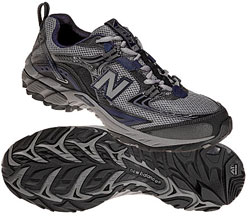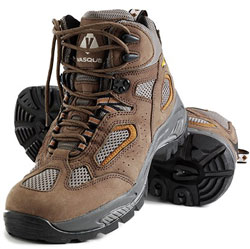Finding shoes that match the strange contours of your feet is hard enough, but I've learned in the past few weeks that the right shoes can be the wrong fit if they're incompatible with local climate and terrain.
I picked up a pair of light, airy trail-runners a couple months back, thinking they'd be just the thing for (my first) steamy North Carolina summer. They were fine and dandy till I bashed my feet against boulders a few times.
For years I recited the modern hiker's mantra: heavy, hearty boots are overkill and lightweight low-risers are fine much of the time. But last week, there I was at the REI down the road, trying on some Vasques with thick padded uppers and deep lugged soles. My feet were practically tap dancing with joy that I'd finally come to my senses.
Back story: I moved across the country last year, from the San Francisco Bay Area to the middle of North Carolina. The climate changes in my new habitat were obvious: hotter and stickier in summer, colder and snowier in winter, stormier all year. The biggest surprise was the trails: while some of the Bay Area trails were steep, they were rarely rugged. Trails in North Carolina can be steep, rocky, and full of roots, and often all three.
Lately I've been exploring Grandfather Mountain State Park, one of the most popular hiking locales in North Carolina's Blue Ridge Mountains. Trail designers here seem to delight in routing trails through boulder fields, where the slightest slip can punish your feet royally if your shoes lack padding and support.
The New Balance trail runners I bought had a lot going for them: perfect fit, low weight, excellent ventilation, decent traction despite small lugs in the soles. They're great for training hikes in a county park within walking distance of my front door, but they're just not built for the rough stuff.
Trail runners should not be counted out for rugged trails: some have beefy soles, extra padding, and ankle support that almost rivals over-the-heel boots (Editor in Chief Alicia MacLeay swears by her La Sportiva Wildcats). I've had excellent luck with Montrails over the years.
I have developed a healthy skepticism for two features common to hiking footwear: high-top construction and Gore-Tex waterproofing. Laces, leather, and thin padding won't save your ankles if you fall hard enough. Gore-Tex just makes hot feet even hotter, and never seems to offer that much waterproofing when I really need it (such as a torrential downpour).
So why did I come home with a pair of over-the-ankle, Gore-Tex-lined Vasque Breezes? Well, they felt right in the store (I buy based on the best fit, not style, brand, reviews, or recommendations from other hikers). The jury's out on how they'll fare in a Southeast summer; so far (about 15 miles), the Gore-Tex does a fine job of preventing dewy grass from soaking my socks. Will they stay as dry in a thunderstorm? I'd love to be surprised.
Buying boots for new terrain is like tuition: the first pair gets you enrolled, the later ones fill out your education. You can't learn it all in the first semester.

 by Tom Mangan
by Tom Mangan











